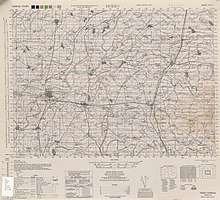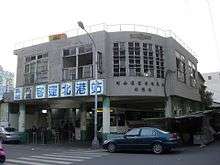Beigang, Yunlin
Beigang or Peikang is an urban township in Yunlin County, Taiwan. It is primarily known for its Chaotian Temple, one of the most prominent Temples of Mazu on Taiwan.[2] It has a population of 40,327 as of November 2017.
Beigang Township 北港鎮 | |
|---|---|
Urban township | |
 Street leading to Chaotian Temple | |
 Beigang Township in Yunlin County | |
 Beigang Township 北港鎮 Beigang Township in Yunlin County | |
| Coordinates: | |
| Location | Yunlin County, Taiwan |
| Area | |
| • Total | 41 km2 (16 sq mi) |
| Population (July 2018) | |
| • Total | 40,118 |
| • Density | 980/km2 (2,500/sq mi) |
| Beigang, Yunlin | |||||||||||
|---|---|---|---|---|---|---|---|---|---|---|---|
| Chinese | 北港 | ||||||||||
| Literal meaning | North Port | ||||||||||
| |||||||||||
Geography


The Beigang River borders the town on the east and south.
History
Dutch Formosa
During the Dutch era, Ponkan (Chinese: 笨港; Pe̍h-ōe-jī: Pùn-káng) was an important coastal castle.[3] In 1621, "Chinese Peter" (顏思齊) from Zhangzhou, Fujian and his forces occupied Ponkan (modern-day Beigang) and started to develop Tsulosan (諸羅山; today's Chiayi City), which grew to become the capital of Tsulo County in 1704.
Administrative divisions
The township comprises 28 villages: Caohu, Dabei, Datong, Fupan, Fuzhao, Gongguan, Gongrong, Gouzao, Guangfu, Guangmin, Haoshou, Hougou, Huasheng, Liucuo, Nanan, Pangou, Renan, Renhe, Shuipu, Shujiao, Sifu, Tunghua, Tungyang, Xincuo, Xinjie, Xishi, Yimin and Zhonghe.
Education
The China Medical University has a branch in Beigang.
Beigang is only a short drive (approximately fifteen minutes by car) from National Chung Cheng University, one of Taiwan's foremost research universities.
Tourist attractions
- Beigang Cultural Center
- Beigang Tourist Bridge, connecting the counties of Yunlin and Chiayi, which are separated by the Beigang River [4]
- Beigang Chaotian Temple, one of the most important Mazu temples in Taiwan and known for its magnificent temple architecture, visited by more than a million pilgrims every year.
- Beigang Wude Temple, one of the largest temple dedicated to Xuan Tan Zhen Jun (玄壇真君), Martial God of Wealth.
- Museum of Beigang Story
- Beigang Water Tower
Local cuisine specialities
- Beigang Cakes (traditional wedding cakes)
- Beigang Peanuts and Broad Beans
Cultural activities
- Festivities around the birthday of Mazu (23rd day of the third month of the lunar year)
- Baishatun Mazu Pilgrimage
- Beigang International Music Festival
Transportation

Bus stations in the county is Beigang Bus Station of Chiayi Bus.
Notable natives
- Alex Tsai, member of Legislative Yuan (2002-2016)
- Su Chih-fen, Magistrate of Yunlin County (2005-2014)
- Wu Se-hwa, Minister of Education (2014-2016)
References
- 教育部重編國語辭典修訂本 (in Chinese). Retrieved 18 November 2019.
字詞 【北港鎮】 注音 ㄅㄟˇ ㄍㄤˇ ㄓㄣˋ 漢語拼音 běi gǎng zhèn
- Keeling, Stephen (2013), "Beigang", The Rough Guide to Taiwan, Rough Guides.
- "Historical Evolution". The Roots of Yunlin. Yunlin County Government. Archived from the original on 6 August 2016. Retrieved 17 December 2014.
- "Cultural Tours in Yunlin - Beigang Tourist Bridge". yunlin.gov.tw. Yunlin County Gov't. 3 August 2015. Archived from the original on 27 May 2014. Retrieved 31 January 2017.
External links
| Wikimedia Commons has media related to Beigang Township, Yunlin County. |
- Yunlin County, Beigang Township Office (in Chinese)
- Introduction of Beigang in the China Post
- National Geographic Traveler Taiwan, ISBN 0-7922-6555-6